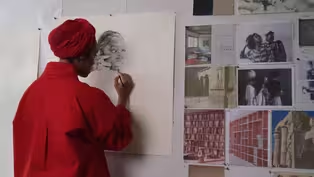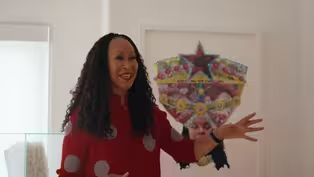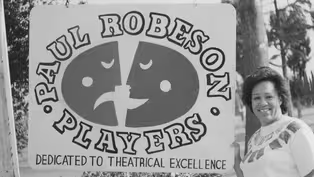
'84 Olympic Freeway Mural Project Pulled Talent From Diverse L.A. Communities
Clip: Season 15 Episode 4 | 3m 56sVideo has Closed Captions
Ten murals in total were commissioned by artists of various ethnic backgrounds and styles.
Artists from all over L.A. stunned international crowds with beautiful murals along the freeways leading in and out of the sporting venues that hosted the Olympics in Los Angeles in 1984. Ten murals in total were commissioned by artists of various ethnic backgrounds and styles including Judy Baca, Kent Twitchell, Alonzo Davis and others.
Problems playing video? | Closed Captioning Feedback
Problems playing video? | Closed Captioning Feedback
Artbound is a local public television program presented by PBS SoCal

'84 Olympic Freeway Mural Project Pulled Talent From Diverse L.A. Communities
Clip: Season 15 Episode 4 | 3m 56sVideo has Closed Captions
Artists from all over L.A. stunned international crowds with beautiful murals along the freeways leading in and out of the sporting venues that hosted the Olympics in Los Angeles in 1984. Ten murals in total were commissioned by artists of various ethnic backgrounds and styles including Judy Baca, Kent Twitchell, Alonzo Davis and others.
Problems playing video? | Closed Captioning Feedback
How to Watch Artbound
Artbound is available to stream on pbs.org and the free PBS App, available on iPhone, Apple TV, Android TV, Android smartphones, Amazon Fire TV, Amazon Fire Tablet, Roku, Samsung Smart TV, and Vizio.
Providing Support for PBS.org
Learn Moreabout PBS online sponsorshipThis is the day that Olympic traffic officials have been dreading that day when competition will be going on at three venues in the same area.
Track and field at the Coliseum in the middle of your screen.
Boxing in the sports arena to the right.
Swimming to the left, nearby.
In all, some 200,000 people will pass through that area today.
1983, we secured support from the Olympic Guards community after being rejected maybe a couple of times and someone spoke to the head of the Olympic Arts Festival about why there were no murals and they said they wouldn't come forward financially unless there were murals.
So out of the trash heap came my proposal.
My goal in Los Angeles was to try to create a festival that had its own validity.
That was a celebration of all of the arts that sort of rejoiced the eye in the year with new things to see and hear.
Given the amount of avant garde work that was in the festival, things that sounded rare and exotic and were like Sankai Juku and Pina Bausch and all of these other wonderful, unpronounceable, mysterious names of artists.
The question was asked and is asked, was it an elitist festival only for the sort of cognoscente to the people who were already in the know?
And my answer is no, it wasn't.
It was deliberately not a black tie kind of festival for the Music Center crowd alone.
It's a festival that welcomes people.
They had gotten an invitation to be a part of the Olympic Arts Festival, and so they invited me to be a part of their project.
So I was an artist in residence in their project.
We commissioned ten artists, including Judy Baca Glenna Boltuch, Kent Twitchell, Richard Wyatt, myself, along with others, to do ten murals on the freeway that led to and from the Coliseum, Harbor Freeway and Hollywood Freeway.
Some of those murals still exist.
And it was very successful adventure and we where we met with Mayor Bradley at the time.
He said, you guys are pretty bodacious.
And we had these discussions along the lines of what it would mean to have all these different ethnic communities in L.A. being able to communicate with each other.
By having formed a nonprofit.
We were able to secure funding and support from various entities, including California Arts Council, City of Los Angeles, National Endowment for the Arts.
So we had that kind of range of participation from the political community, the entertainment community, as well as the business community, and therefore we could do events for free because we had the capital to make it happen.
And when that dried up, we dried up.
Black Art: A Brockman Gallery Legacy (Preview)
Preview: S15 Ep4 | 30s | Brockman Gallery was the center of a community of Black artists in L.A. from 1967-1990. (30s)
Dr. Joy Simmons' Collection Represents Decades of African American Art
Clip: S15 Ep4 | 1m 57s | One of the most important African American art collections lives in a Los Angeles home. (1m 57s)
The Legacy of the Paul Robeson Players in 1970s L.A. Black Theater
Video has Closed Captions
Clip: S15 Ep4 | 12m 4s | In 1970s Compton, the Paul Robeson Players emerge as one of L.A.'s longest-running Black theaters. (12m 4s)
Providing Support for PBS.org
Learn Moreabout PBS online sponsorshipSupport for PBS provided by:
Artbound is a local public television program presented by PBS SoCal














